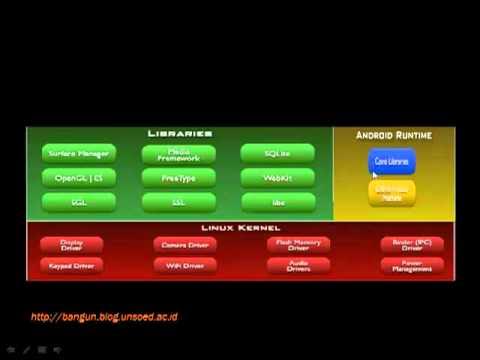Overview of Android Layers (Part 1)
Summary
TLDRThis transcript explores key aspects of Android's architecture, focusing on the role of the Linux kernel, hardware abstraction layer (HAL), and Android's custom virtual machine, Dalvik. It discusses the technical reasons for placing hardware drivers in user space, bypassing open-source licensing challenges, and optimizing performance through Just-In-Time (JIT) and Ahead-Of-Time (AOT) compilers. Additionally, the transcript touches on Android’s shift to Android Runtime (ART) and highlights how concurrent programming and garbage collection are integrated within the system. The lecture also mentions the postponement of an upcoming quiz.
Takeaways
- 😀 The Android operating system kernel acts as a traffic cop, managing the flow of information within the system.
- 😀 The Hardware Abstraction Layer (HAL) allows communication between hardware drivers and the OS without embedding them directly in the kernel, to avoid issues with open-source licensing.
- 😀 Mobile devices like smartphones require additional hardware drivers (e.g., radio, cameras) that are not typically found in desktop Linux systems.
- 😀 Manufacturers use user-level drivers in the HAL to avoid releasing proprietary driver code as open-source, which would be required if included in the Linux kernel due to GPL licensing.
- 😀 The GNU Public License (GPL) mandates that modifications to the Linux kernel, including drivers, must be released as open-source, which is often a concern for manufacturers.
- 😀 Android uses its own custom virtual machine called Dalvik, which differs from the standard Java Virtual Machine (JVM), to run Android applications.
- 😀 Android applications are compiled into Android-specific bytecode, which runs on the Dalvik or ART virtual machines, not directly on the standard JVM.
- 😀 Just-in-time (JIT) compilation in Dalvik compiles frequently executed bytecode into native code during runtime, improving performance.
- 😀 Android is moving toward Ahead-of-time (AOT) compilation with the ART virtual machine, where Java code is compiled into native code before runtime to improve efficiency.
- 😀 The Android runtime (ART) also features improved garbage collection and concurrent programming capabilities to manage memory and allow multiple processes to run smoothly.
- 😀 The upcoming quiz will focus on the topics covered so far, and has been postponed to the following Wednesday to give students more time to review the material.
Q & A
What role does the kernel play in an operating system?
-The kernel acts as a traffic cop, managing the flow of information and ensuring security by controlling access to hardware resources and enforcing permissions.
What is the Hardware Abstraction Layer (HAL) in Android, and why is it important?
-The HAL provides an interface between the hardware and the operating system, abstracting hardware-specific details to make it easier for the OS to interact with various hardware components. This is especially important for managing diverse hardware in Android devices like smartphones.
Why does Android use user-space drivers instead of kernel drivers?
-Android uses user-space drivers to avoid the need for device manufacturers to release proprietary driver source code under the GNU General Public License (GPL), which requires that all code be open-source. By placing drivers in user space, manufacturers can protect their competitive advantage.
How does Android's approach to open-source licensing differ from traditional Linux kernels?
-Android's approach to open-source licensing is different because it moves hardware-specific drivers to user space, circumventing the need for manufacturers to release proprietary code. This is due to the open-source nature of the GNU General Public License, which mandates the release of source code for GPL-licensed software.
What is the difference between Dalvik and the traditional Java Virtual Machine (JVM)?
-Dalvik is a custom virtual machine designed specifically for Android. Unlike the traditional JVM, which executes Java bytecode, Dalvik uses a different bytecode format optimized for mobile devices with lower memory and processing power. Android has since moved to ART (Android Runtime), which is more efficient and supports ahead-of-time (AOT) compilation.
What is the purpose of the Android Runtime (ART) and how does it differ from Dalvik?
-ART is a new runtime environment that replaces Dalvik in Android. It supports ahead-of-time (AOT) compilation, where Java code is compiled into native machine code during installation, leading to improved performance. Unlike Dalvik's just-in-time (JIT) compilation, ART provides faster execution and better memory management.
How does ahead-of-time (AOT) compilation in ART improve the performance of Android apps?
-AOT compilation improves performance by converting Java code into native machine code during installation, rather than compiling it on the fly during execution like Dalvik's JIT. This reduces the need for on-the-fly compilation and speeds up app startup and execution.
What are the benefits of the improved garbage collection in ART?
-The improved garbage collection in ART helps manage memory more efficiently, reducing the chances of memory leaks and improving overall performance by cleaning up unused objects more effectively during app execution.
How does Android handle concurrency and parallelism in virtual machines like Dalvik and ART?
-Both Dalvik and ART support concurrent programming features, which allow multiple tasks or processes to run in parallel across multiple processor cores. These features help Android apps manage multitasking more efficiently, ensuring better performance on devices with multiple cores.
Why is Android's approach to mobile OS development distinct from other operating systems like standard Linux?
-Android's approach is distinct due to its focus on supporting mobile hardware components (like cellular radios and cameras), which aren't typically found in traditional Linux environments. This led to custom user-space drivers and a unique runtime (Dalvik and later ART), optimized for the constraints of mobile devices.
Outlines

This section is available to paid users only. Please upgrade to access this part.
Upgrade NowMindmap

This section is available to paid users only. Please upgrade to access this part.
Upgrade NowKeywords

This section is available to paid users only. Please upgrade to access this part.
Upgrade NowHighlights

This section is available to paid users only. Please upgrade to access this part.
Upgrade NowTranscripts

This section is available to paid users only. Please upgrade to access this part.
Upgrade NowBrowse More Related Video
5.0 / 5 (0 votes)





